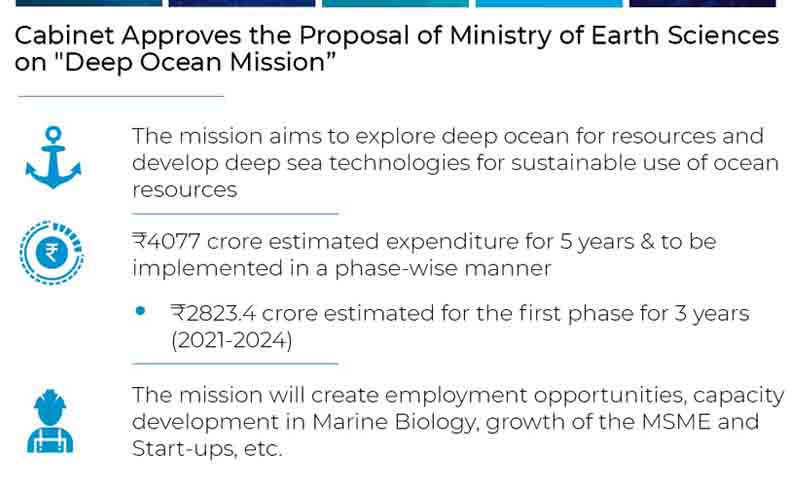- India
- Jun 17
Explainer / Deep Ocean Mission
The Union Cabinet approved a proposal to roll out a ‘Deep Ocean Mission’ to explore the deep ocean for resources and develop deep-sea technologies for sustainable use of marine resources.
The proposal for launching the ‘Deep Ocean Mission’ came from the ministry of earth sciences.
Significance of this mission
• India has been allotted a site of 75,000 sq km in the Central Indian Ocean Basin (CIOB) by the UN International Seabed Authority for exploitation of polymetallic nodules (PMN).
• Polymetallic nodules (also known as manganese nodules) are potato-shaped, largely porous nodules found in abundance carpeting the sea floor of world oceans in deep sea. Besides manganese and iron, they contain nickel, copper, cobalt, lead, molybdenum, cadmium, vanadium, titanium, of which nickel, cobalt and copper are considered to be of economic and strategic importance.
• Being able to lay hands on even 10 per cent of that reserve can meet India’s energy requirements for the next 100 years.
• It has been estimated that 380 million metric tonnes of polymetallic nodules are available at the bottom of the seas in the central Indian Ocean.
• India’s Exclusive Economic Zone is spread over 2.2 million sq km.
Highlights of the mission:
• The estimated cost of the mission for a period of five years will be Rs 4,077 crore and it will be implemented in a phase-wise manner.
• The estimated cost for the first phase for the three years (2021-2024) would be Rs 2,823.4 crore. The Deep Ocean Mission will be a mission-mode project to support the blue economy initiatives of the government.
• The ministry of earth sciences (MoES) will be the nodal ministry implementing this multi-institutional ambitious mission.
The mission consists of six major components:
1) Development of technologies for deep-sea mining and manned submersible: A manned submersible will be developed to carry three people to a depth of 6,000 metres in the ocean with a suite of scientific sensors and tools. Only a very few countries have acquired this capability. An Integrated Mining System will be also developed for mining polymetallic nodules from 6,000 m depth in the central Indian Ocean. The exploration studies of minerals will pave the way for commercial exploitation in the near future, as and when commercial exploitation code is evolved by the International Seabed Authority, an UN organisation. This component will help exploring and harnessing deep sea minerals and energy.
2) Development of ocean climate change advisory services: A suite of observations and models will be developed to understand and provide future projections of important climate variables on seasonal to decadal time scales under this proof of concept component. This component will support the blue economy priority area of coastal tourism.
3) Technological innovations for exploration and conservation of deep-sea biodiversity: Bio-prospecting of deep sea flora and fauna including microbes and studies on sustainable utilisation of deep sea bio-resources will be the main focus. This component will support the blue economy priority area of marine fisheries and allied services.
4) Deep ocean survey and exploration: The primary objective of this component is to explore and identify potential sites of multi-metal Hydrothermal Sulphides mineralisation along the Indian Ocean mid-oceanic ridges. This component will additionally support the blue economy priority area of deep sea exploration of ocean resources.
5) Energy and freshwater from the ocean: Studies and detailed engineering design for offshore Ocean Thermal Energy Conversion (OTEC) powered desalination plants are envisaged in this proof of concept proposal. This component will support the blue economy priority area of off-shore energy development.
6) Advanced marine station for ocean biology: This component is aimed at the development of human capacity and enterprise in ocean biology and engineering. This component will translate research into industrial application and product development through on-site business incubator facilities. This component will support the blue economy priority area of marine biology, blue trade and blue manufacturing.
• The technologies required for deep-sea mining have strategic implications and are not commercially available. Hence, attempts will be made to indigenise technologies by collaborating with leading institutes and private industries.
• A research vessel for deep-ocean exploration would be built in an Indian shipyard, which would create employment opportunities.
• This mission is also directed towards capacity development in marine biology, which will provide job opportunities in Indian industries.
• In addition, design, development and fabrication of specialised equipment, ships and setting up of the required infrastructure are expected to spur the growth of the Indian industry, especially the MSMEs and startups.
Manorama Yearbook app is now available on Google Play Store and iOS App Store


